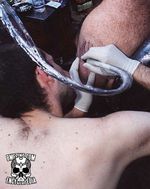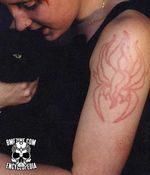Mamiya Technique
Dremel scarification (also known as "abrasive scarification") is a form of scarification wherein layers of skin are ground away using the rotating abrasive tip of rotary tools like a dremel. Abrasive scarification is generally used to create subtle unraised scars, but it can be used to create almost every type and texture of scar.
The technique is bloody and can potentially fling pathogens into the atmosphere and surfaces around the area in which the modification is being performed so extreme care must be taken to avoid contamination. The healed scars produced using this method tend to be pale and minimally raised, but the technique offers excellent control over line contour.
This method of scarification is also known as the "Mamiya Technique", named after one of its first pioneers, Eizo Mamiya of Tokyo, Japan.
Tools
This type of scarification derives it name from the frequently used Dremel hobby tool, but some artists are experimenting with a variety of abrasive tools, including vibrating glass engraving tools.

